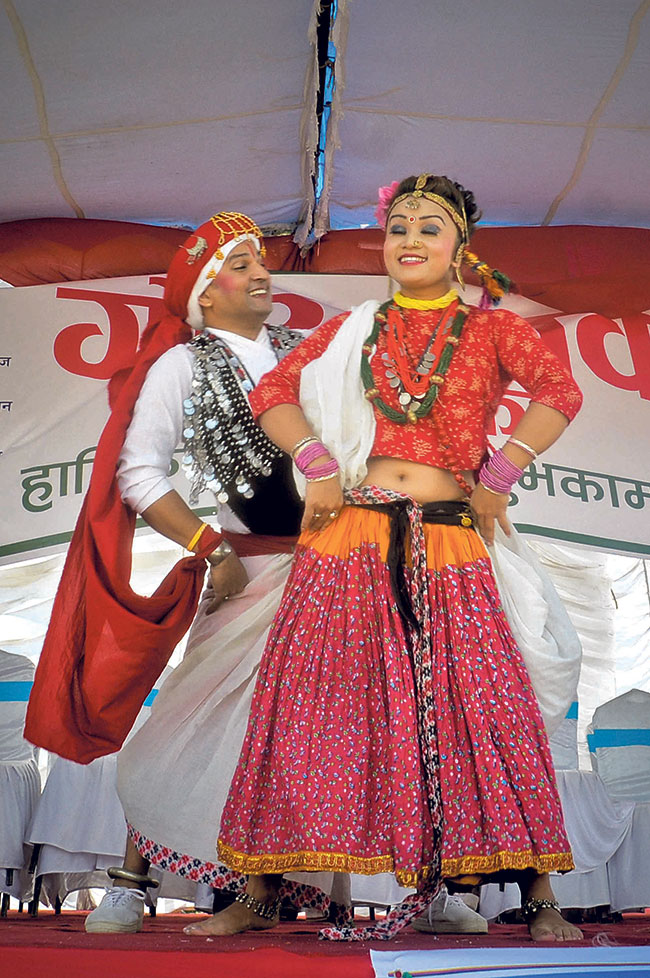
Gaura marks the marriage of Goddess Gauri and Lord Maheshwar, one of the many incarnations of Lord Shiva.
Women in the far-western development region celebrated Gaura festival amid much fanfare on Tuesday. Goddess Gauri, also known as Parvati, is worshipped during the festival and women observe fast on the occasion praying for their husband and children’s longevity.
Gaura marks the marriage of Goddess Gauri and Lord Maheshwar, one of the many incarnations of Lord Shiva.
Deuda is another popular tradition related to the Gaura festival, where people of all ages and gender sing and dance with great zeal. Gaura carries cultural and religious significance not only in the far-west region of Nepal but also in Uttar Pradesh of India. “The centuries-old Gaura festival helps in uniting people of all social strata and is known as a symbol of ‘unity in diversity’,” a lecturer of Doti Bahumukhi Campus, Dr Badri Binadi.
It is believed that on this day, Gauri, the daughter of Himalayas, fasted for several days and prayed longingly to get Lord Shiva as her significant other. “Gaura has been mentioned in the ancient transcripts several times. The scripts refer that women observe fast on the occasion to show gratitude for the life they’re given and for the good health of their families.”
“The centuries-old Gaura festival helps in uniting people of all social strata and is known as a symbol of unity in diversity”
Gaura usually begins on Bhadra Shukla Punchami, which is also known as Biruda Panchami. The festival is started by soaking five different types of grains and beans, also called Biruda. “Although the festival officially starts from Punchami, the preparations begin from Aunsi,” local woman leader Parvati Chanda said.
The second day is a day of fasting during which women prepare portraits of Gaura Devi in the wee hours at water sources by washing the Biruda collectively. On the day of saptami, the married women welcome the Gaura deity and establish them in the ‘Gauraghar.’
Mangal-gaan is sung during this process. Pure mud is spread all over the Gauraghar and the statue is placed in a bamboo-made container to worship. The women undertaking fasts tie dubo (Cynodon) bracelets, which are significant for the festival, according to Binadi.
“The dubo bracelet is as important for females as janai (a sacred thread) is for males. The day of Ashtami is very important and is also called Gaura-ashtami. On this day, the Gaura welcomed on Saptami is worshipped, while revelers dance along the tunes of Mangal-dhun,” said Astrologer and President of Dilpeshwor Sanatan Satsang, Dipayal, Meghraj Bhatta.
“Then the Gaura is brought to the court of the house and people dance to several traditional songs such as Chaita and Dhamari. They sing about the bravery tales of kings from the past.” Traditionally, playing Deuda also starts from this day.

Photo by Dinesh Gole
Gaura is also known as Gamara, Go: ra or Gawara in the far-west, which are all forms of Parvati.
According to Binadi, Gaura represents the local culture, traditions, literature, historical scriptures and identity. “There is no other opportunity where these diverse ethnicities come together. Gaura is an important time for anyone who wants to observe a variety of art, culture, and languages of the far-west come together,” he said.
It is also believed that Gaura marks the end of the rainy season. Young and old, men and women together sing songs to express their love and brotherhood on the occasion. People perform traditional forms of dance like the Deuda, Magal, Phag, Chachari, Dhamari and Chaliya. Various delicious recipes are also prepared like batuk chukuwani, mada, laun, puri, sel-roti, kheer.
The festival ends with the consignment of the goddess Gaura under a tree, which is known as Gaura Bisharjan.


Leave A Comment